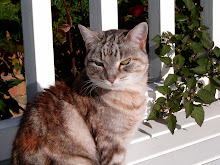We are continuing from where we left off from yesterdays post.
Going up the steep pathway on the upper trail is a lovely display of spring flowers mingling on and surround the grave stones. The perfume follows us as we walk.
It is really a beautiful day and we are surrounded by beautiful scenery. Even with the motorway right next to us, you forget that it is even there. We don't even hear the cars driving by.
In this cemetery only 1334 of the gravestones are still visible since having the motorway built and due to old age. Also some of the oldest graves were just simple wooden markers used mainly by the poorest settlers. Later, even cast iron was used as markers.
This grave is in the Jewish part of the cemetery. It is planted with lovely blue flowers with a rosemary bush in the middle.
It is situated on the edge of the Hort Lawn which is part of the Jewish Cemetery and was still vacant when the cemetery was closed in 1892.
Less than half of the 1334 gravestones are in their original positions. You can easily recognise the reinstated gravestones as they are grouped close together and are without fences or bases.
It will be nice to come back later when all the roses are in bloom as the cemetery has a large collection of heritage roses which are of national significance.
This memorial was dedicated to Henry Edmund Holland who was a New Zealand politician and unionist. He was the first leader of the New Zealand Labour Party.
He was also one of the founding members, although his opinions about the direction of the party were not the same as some of the party's other leaders. Holland had believed that the Labour Party would lay the foundations for socialism. More moderate members of the party simply wanted to improve the wages and conditions of workers.
.jpg/220px-Harry_Holland_(1925).jpg) |
| Henry "Harry" Holland |
During the Great Depression, he believed that it marked the beginning of the end for capitalism. But the economic problems continued with many workers cast into poverty, he then began to question whether his theories were capable of solving this crisis. Holland started to suffer from depression, exhaustion, and ill health, and began to withdraw from the activities of leadership.
In 1933 he died suddenly of a heart attack at the funeral of Te Rata Mahuta. He was given a State Funeral and was succeeded by the more moderate Michael Joseph Savage who lead the Labour Party to victory in the 1935 elections.
It's great exploring the old gravestones and seeing Wellington's history. Looking closer, they all have stories to tell.
For example, this one pictured above, is in the memory of William Heighton who was in the New Zealand Torpedo Corps and died in an accidental explosion at Shelly Bay here in Wellington.
And Henry Gardiner and his wife Lucy. They must have met and married over her in New Zealand as they had arrived on different ships and years. He arrived on the H.M. Survey Ship Acheron in 1947, and Lucy arrived in 1841 on the Lady Nugent.
Tune in tomorrow for another installment of our Spring Expedition...........


























No comments:
Post a Comment